Gingerbread cookies are a staple at Christmas time, and we made an allergy friendly version! Our gluten free gingerbread cookies are soft and chewy in the middle, slightly crisp on the outside, and perfect for frosting or eating plain. Our gingerbread cookies are also vegan and nut free!
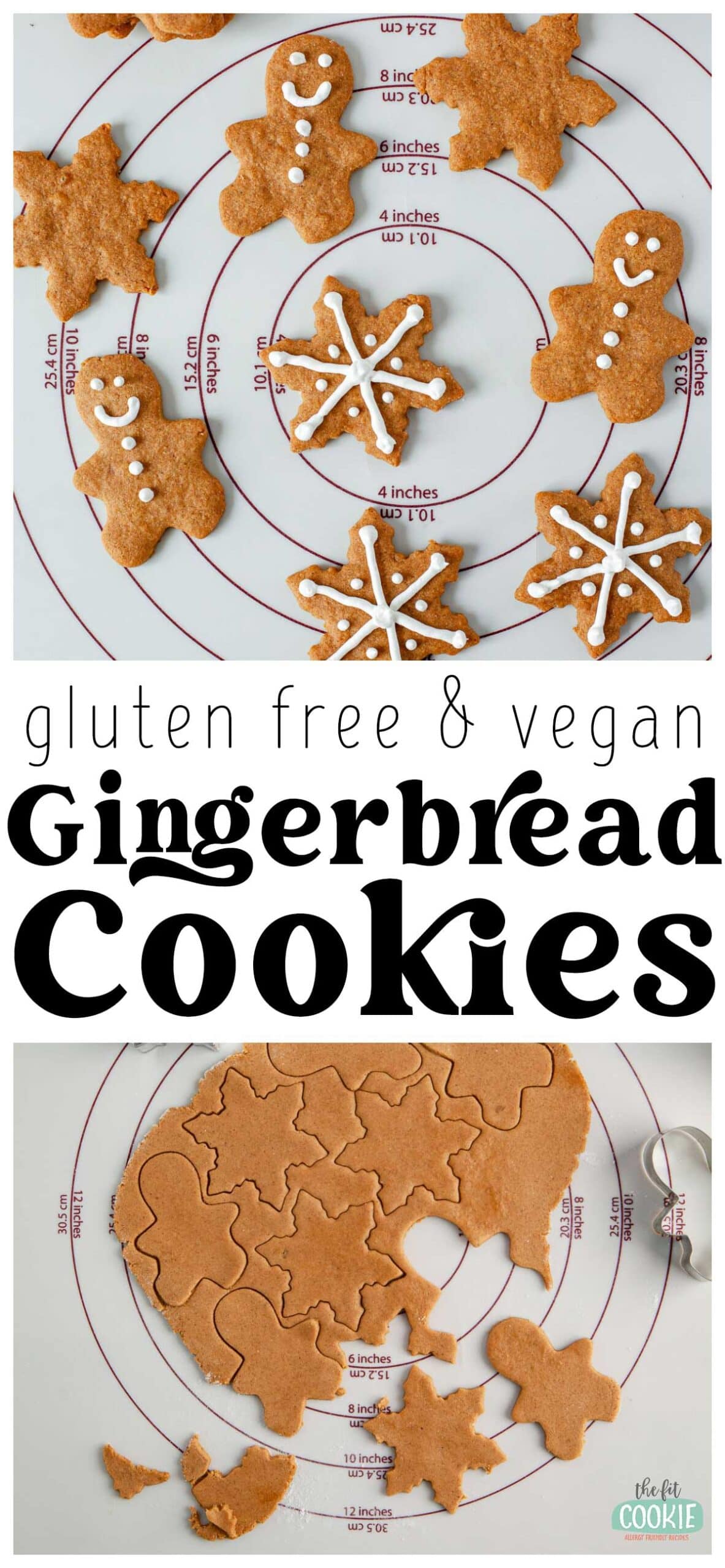
One of readers recently asked for an allergy friendly gingerbread cookie recipe, so we set to work on creating a gluten free and vegan gingerbread recipe just in time for Christmas!
Does anyone else remember the story of the gingerbread boy who comes to life and runs amok in town, and everyone chases him? I remember reading that story as a kid and wondering why no one could catch it. I mean, how fast could a cookie with 2-inch legs run? 😂
Even though I loved fantasy fiction (and still do), my kid brain still didn’t like the idea of a cookie outrunning a bunch of adults.
Coming back from the rabbit trail down memory lane: our allergy friendly version of gingerbread cookies are soft and chewy in the middle and slightly crispy on the edges. They are perfect for giving as gifts for Christmas or just to enjoy some cookie baking on a snowy day.
Our gingerbread cookies aren’t super sweet, so they are perfect with frosting added to make them even more sweet and they won’t be overly sweet when you add frosting.
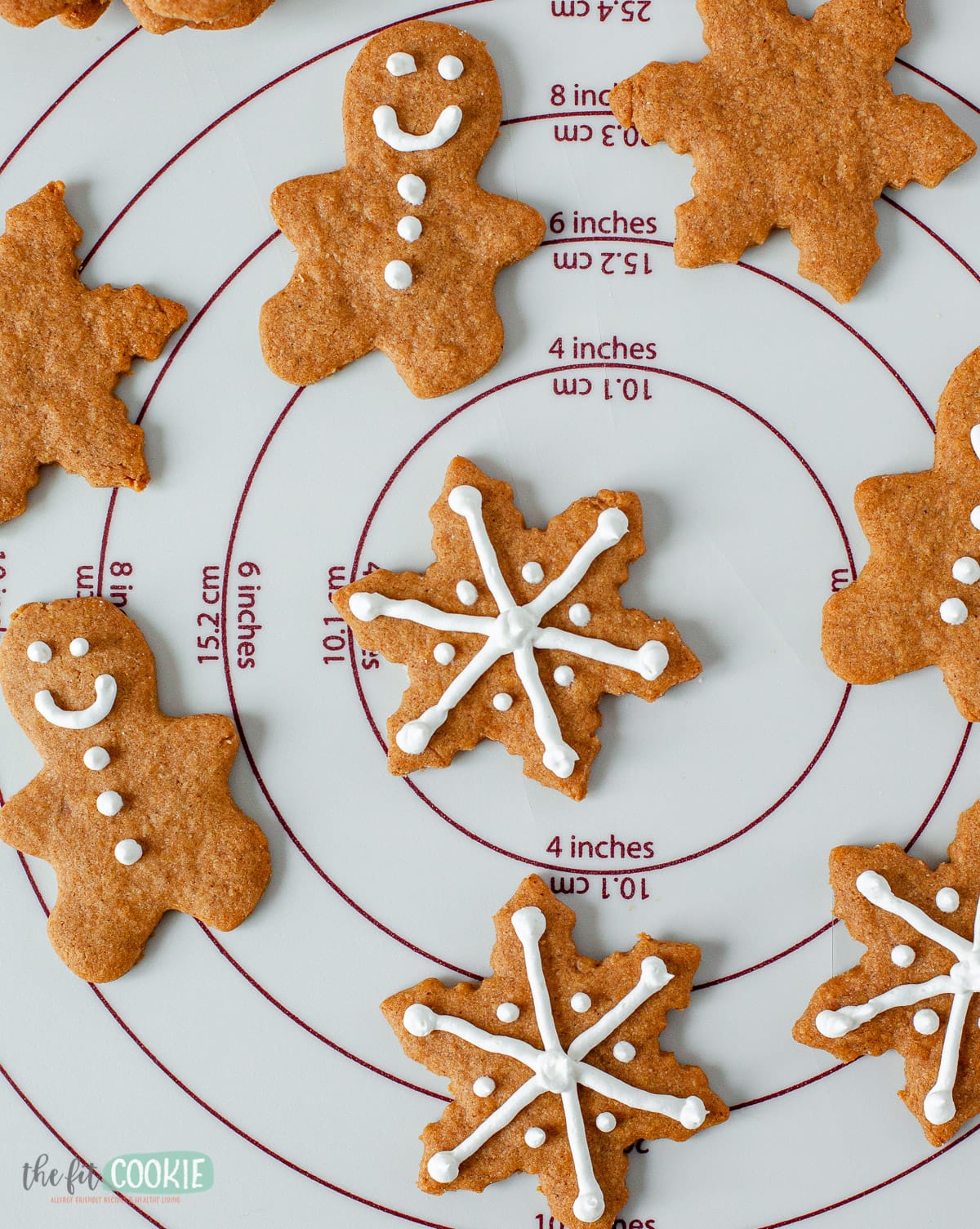
They are pretty easy to make, too, and don’t require chilling the dough first!
Our gingerbread cookies are:
- Gluten free
- Dairy Free
- Vegan and egg free
- Peanut free
- Tree nut free (depending on the dairy free butter you use)
- Soy free (depending on the dairy free butter you use)
How to make gluten free gingerbread cookies
Here are the details on how to make our vegan gingerbread cookies along with tips, don’t skip reading this! The full printable recipe card is at the end of the post.
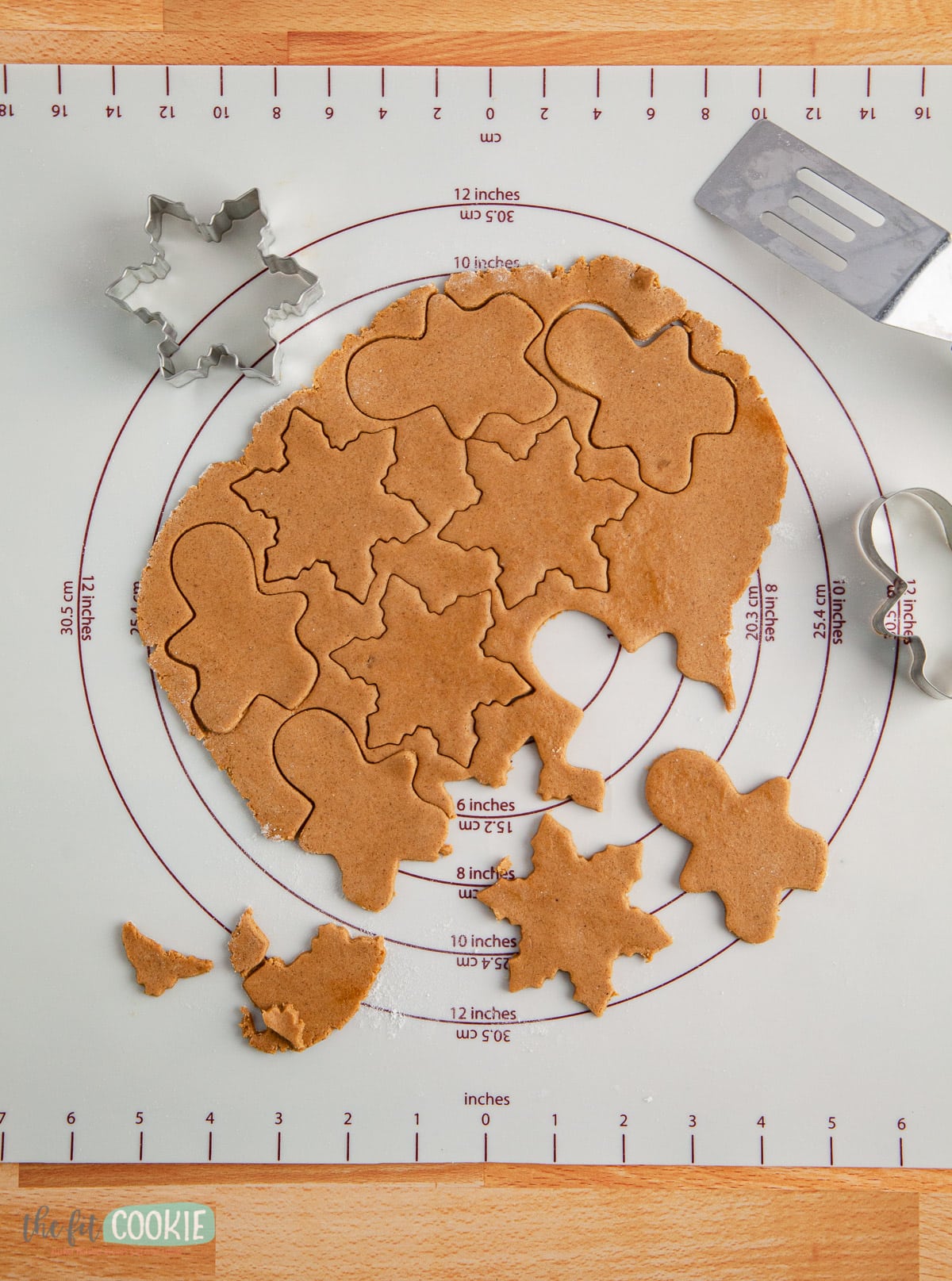
- Preheat the oven to 350 degrees F. Line a baking sheet with parchment paper and set aside.
- In a medium bowl, beat together the dairy free butter, brown sugar, molasses, and vanilla.
- In a separate small bowl, whisk together the flours, spices, and salt.
- Add half the flour mixture to the butter mixture and blend together.
- Add the rest of the flour mix to the bowl with the oat/rice milk and beat together until a thick dough forms that sticks together when pressed together. Mixing the flour in parts makes it much easier to mix the dough.
- If the dough seems a little dry and doesn’t come together, add more milk 1 teaspoon at a time, mixing and testing how cohesive it is after each addition, until a thick dough forms. It needs to be thick and able to rolled out (so not too soft or moist).
- If the dough seems a little too moist to roll, add an additional 1-2 Tablespoons gluten free baking mix flour and chill the dough for 1-2 hours to help it firm up a bit before rolling.
- Divide dough into 2 balls, flatten slightly into disks. While rolling one disc of dough, wrap the other one with plastic wrap to keep it from drying out. If you are cutting out large shapes (like gingerbread house pieces), don’t divide the dough.
- Flour a pastry mat with some of the gluten free flour and roll out one of the cookie dough disks 1/8 to 1/4 inch thick and cut out with cookie cutters.
- Use a lightly floured spatula to lift the cut out cookies onto the baking sheet.
- Press the scraps together, roll out again, and cut again until most (or all) of the cookie dough is used up.
- Repeat all steps with the other cookie dough disk until all the dough is used.
- Bake the cookies for 8 minutes depending on how thick your cookies are. If you have thicker cookies, you can bake for 9 minutes, but don’t cook much longer than this or they will get crunchy and hard.
- Allow the cookies to cool about 10 minutes on the pan before moving to a cooling rack. They will firm up as they cool and will seem pretty soft at first so they’ll need to cool a bit before moving onto the cooling rack.
- Cool completely before adding frosting or icing.
For the best texture, small shape cookies should be baked for 6-7 minutes, and the dough shouldn’t be rolled less than 1/8th inch. Between 1/8 to 1/4 inch is ideal!
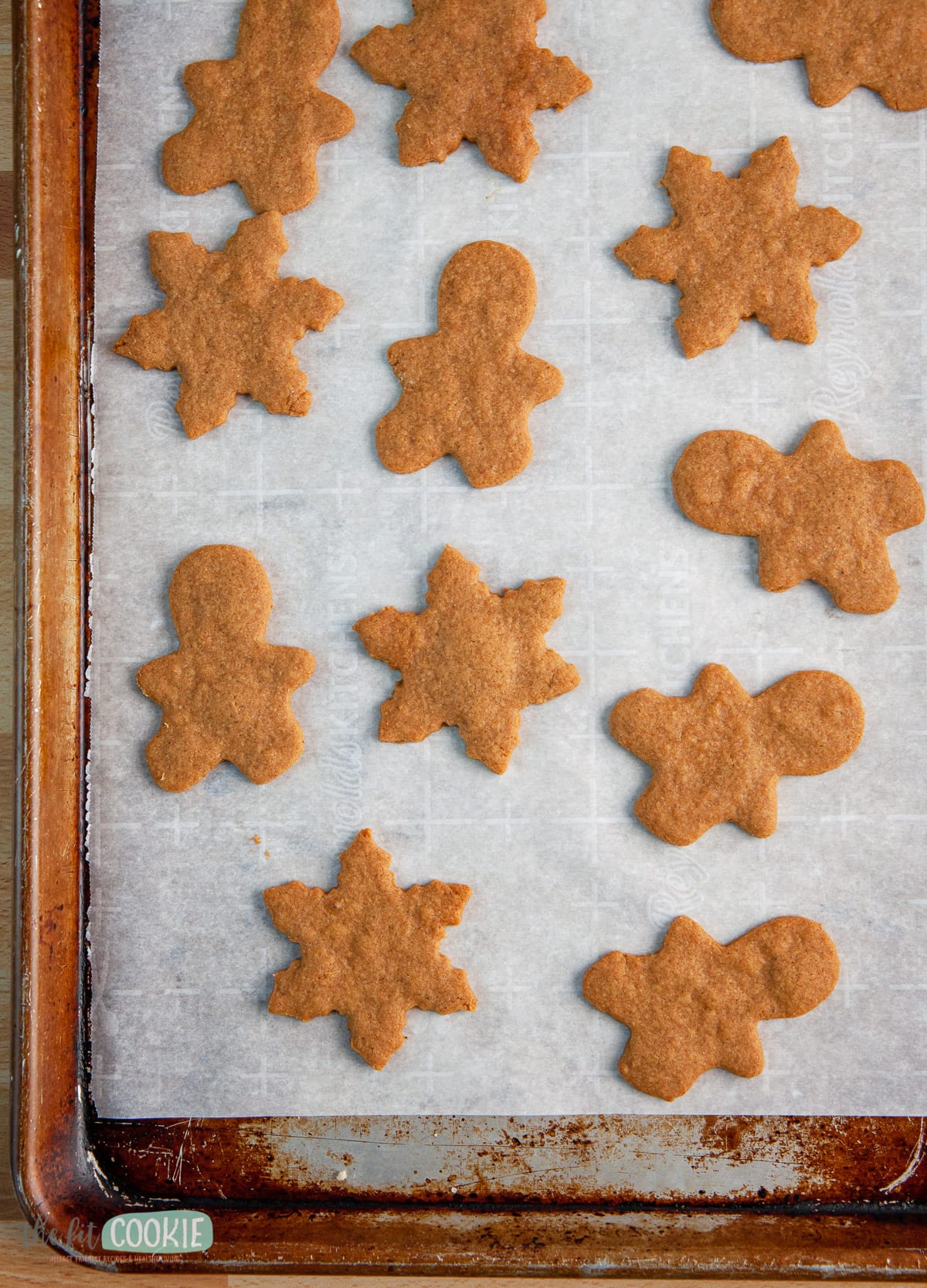
For frosting the cookies, use our dairy free buttercream frosting recipe. It works great for piping designs, that’s what we used for the cookies in our photos.
Mixing the flour into the butter mixture in parts will make the mixing much easier. If you skip this and add all the flour at once, the mixture will look too dry and it will be tempting to add more milk, making it harder to roll out.
What brands of dairy free butter to use in these gingerbread cookies
For these cookies, I recommend using a dairy free butter that is more firm at room temperature, like Country Crock plant butter sticks or the Flora plant butter. The Country Crock plant butter sticks do not have soybean oil in them but the tubs do, so make sure to read the labels if you have soy allergies.
We created this recipe using the Country Crock plant butter sticks, so I recommend using that brand first (if you can have it) for the best results.
I do not recommend using Earth Balance dairy free butter in this recipe since it tends to be too soft at room temperature and can make the cookies spread out too much. I’ve found that Earth Balance works best in cookies that are created using that brand of dairy free butter (like some of our older cookie recipes).
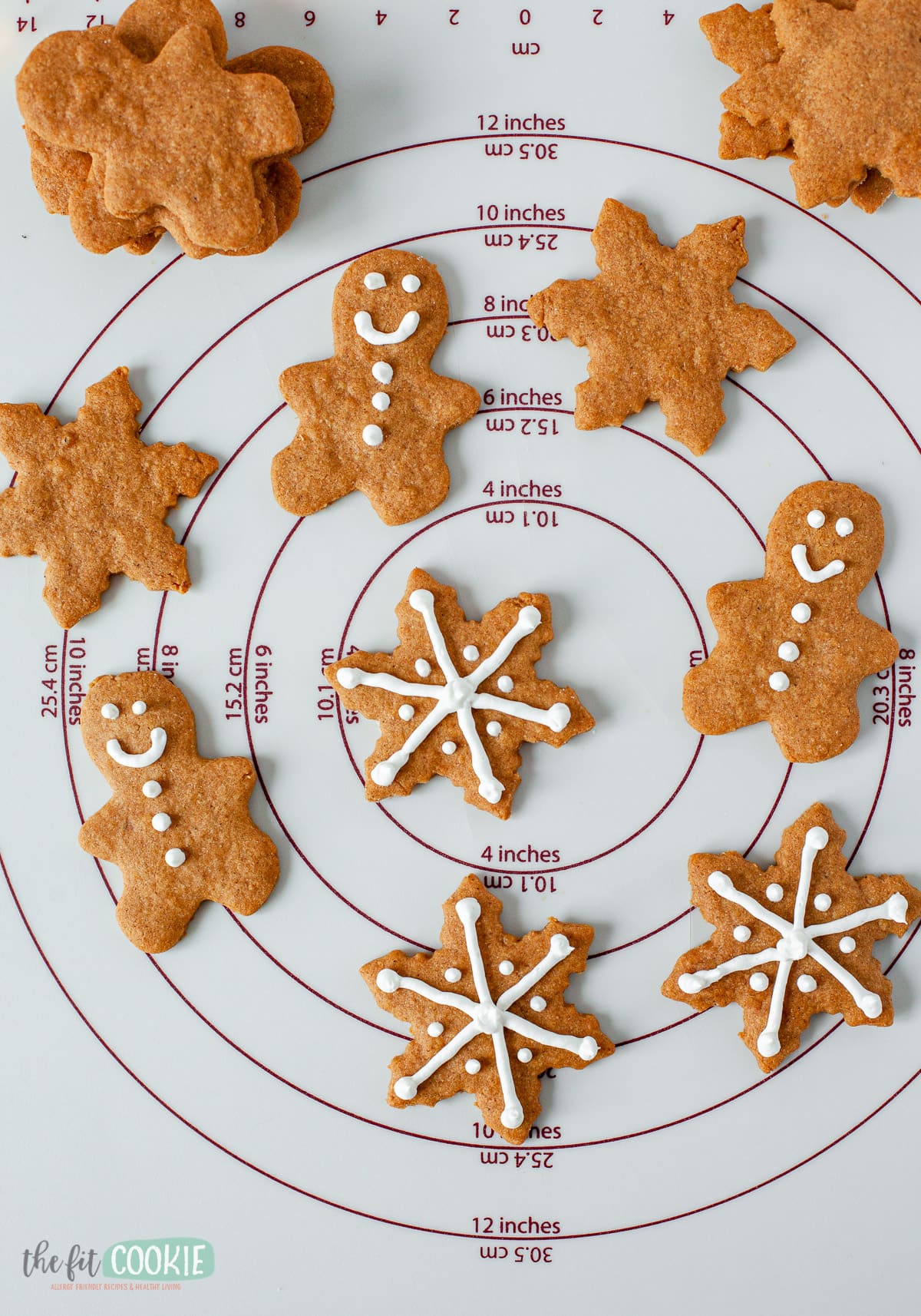
Do I need to chill this cookie dough?
We’ve done both with this recipe (chilling and not chilling) and found that you really don’t have to chill this gingerbread dough before rolling and cutting. I rolled this out and cut it fine without having to chill the dough first.
The only time chilling the dough would be necessary in this recipe is if your dough is slightly too moist or too sticky and doesn’t roll out easily. If that happens, you can mix in an additional tablespoon of flour and chill the dough for 1-2 hours to firm it up for easier rolling and cutting.
For thicker and softer gingerbread cookies
If you’d like a softer gingerbread cookie, roll the dough out to 1/4 inch thickness and cut your shapes, bigger shapes (2-3 inches) are idea for softer cookies with this dough.
Bake the cookies for 8-9 minutes and allow them to cool for 10 minutes before removing from the baking pan to a cooling rack. As soon as they are completely cool, store them in an airtight container or bag to keep them soft.
Check out our allergy friendly Christmas cookie roundup!
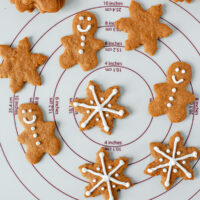
Gluten Free Gingerbread Cookies (Vegan)
Ingredients
- ⅓ cup dairy free butter, softened (we recommend using a firm DF butter, avoid using Earth Balance since it's too soft)
- ½ cup packed brown sugar
- 2 Tablespoons molasses
- 1 teaspoon vanilla
- ¾ cup fine sorghum flour (we use Authentic Foods superfine sorghum flour)
- ½ cup gluten free all purpose baking mix* (we used King Arthur gluten free baking mix)
- 1 ½ teaspoons ground ginger (use less if you want less ginger taste)
- 1 teaspoon ground cinnamon
- ¼ teaspoon salt
- ⅛ teaspoon ground cloves
- Dash allspice
- 1 to 1 ½ Tablespoons oat or rice milk
- Dairy Free Buttercream Frosting
Instructions
- Preheat the oven to 350 degrees F. Line a baking sheet with parchment paper and set aside.
- In a medium bowl, beat together the dairy free butter, brown sugar, molasses, and vanilla.
- In a separate small bowl, whisk together the flours, spices, and salt.
- Add half the flour mixture to the butter mixture and blend together.
- Add the rest of the flour mix to the bowl with the oat/rice milk and beat together until a thick dough forms that sticks together when pressed together. Mixing the flour in parts makes it much easier to mix the dough.
- If the dough seems a little dry and doesn't come together, add more milk 1 teaspoon at a time, mixing and testing how cohesive it is after each addition, until a thick dough forms. It needs to be thick and able to rolled out (so not too soft or moist).
- If the dough seems a little too moist to roll, add an additional 1-2 Tablespoons gluten free baking mix flour and chill the dough for 1-2 hours to help it firm up a bit before rolling.
- Divide dough into 2 balls, flatten slightly into disks. While rolling one disc of dough, wrap the other one with plastic wrap to keep it from drying out. If you are cutting out large shapes (like gingerbread house pieces), don't divide the dough.
- Flour a pastry mat with some of the gluten free flour and roll out one of the cookie dough disks 1/8 to 1/4 inch thick and cut out with cookie cutters.
- For the best texture, the dough shouldn't be rolled less than 1/8th inch. Between 1/8 to 1/4 inch is ideal.
- Use a lightly floured spatula to lift the cut out cookies onto the baking sheet.
- Press the scraps together, roll out again, and cut again until most (or all) of the cookie dough is used up.
- Repeat all steps with the other cookie dough disk until all the dough is used.
- Bake the cookies for 8 minutes. If you have thicker cookies, you can bake for 9 minutes, but don't cook much longer than this or they will get crunchy and hard. Small shapes should be baked for 6-7 minutes.
- Allow the cookies to cool about 10 minutes on the pan before moving to a cooling rack. They will firm up as they cool and will seem pretty soft at first so they'll need to cool a bit before moving onto the cooling rack.
- Cool completely before adding frosting or icing.
For thicker and softer gingerbread cookies:
- If you'd like a softer gingerbread cookie, roll the dough out to 1/4 inch thickness and cut your shapes, bigger shapes (2-3 inches) are idea for softer cookies with this dough.
- Bake the cookies for 8-9 minutes and allow them to cool for 10 minutes before removing from the baking pan to a cooling rack. As soon as they are completely cool, store them in an airtight container or bag to keep them soft.
Video
Notes
Nutrition
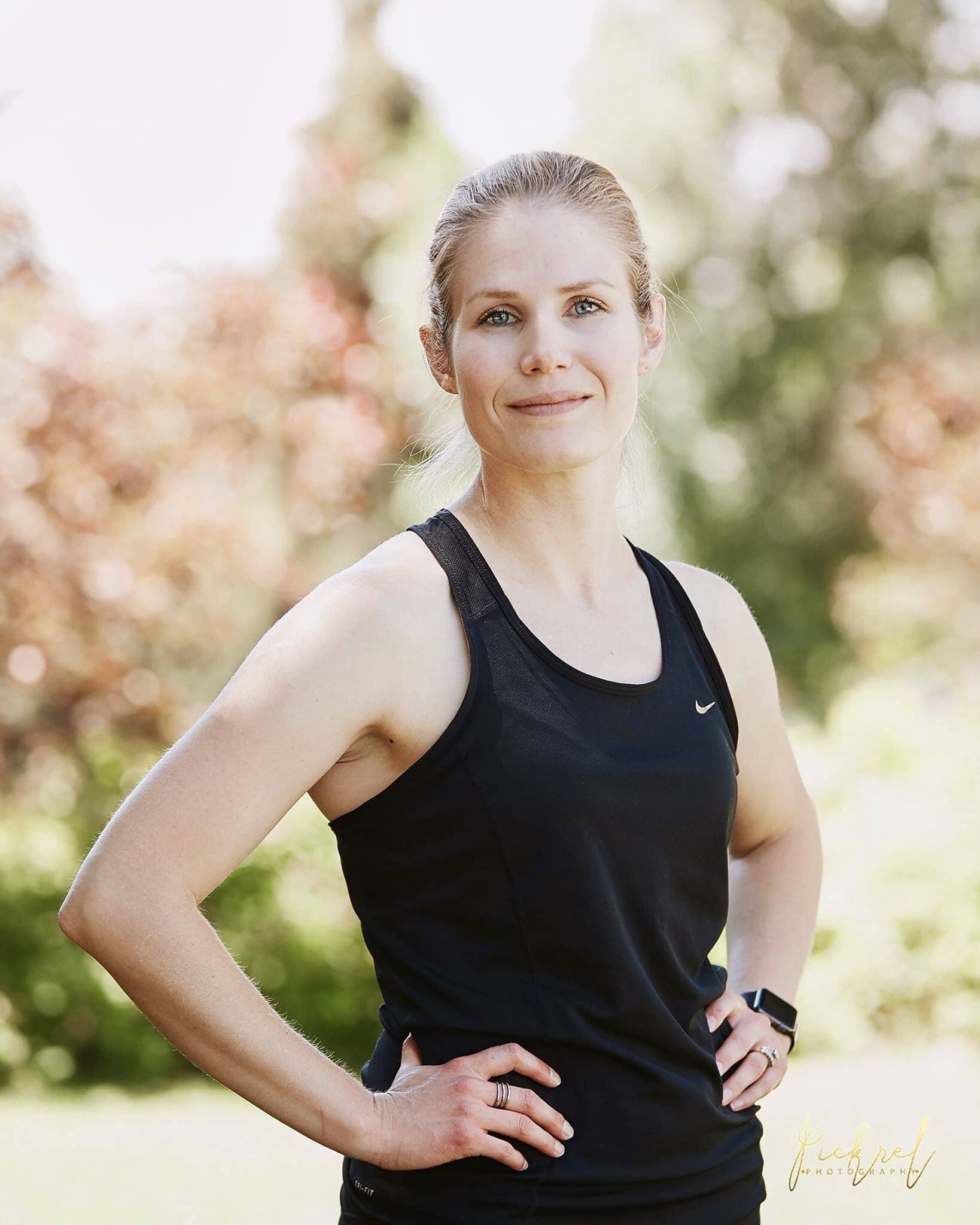
Sarah Jane Parker is the founder, recipe creator, and photographer behind The Fit Cookie. She’s a food allergy mom and healthy living blogger based in Wyoming. Sarah is also an ACSM Certified Personal Trainer, ACE Certified Health Coach, Revolution Running certified running coach, and an ACE Certified Fitness Nutrition Specialist
